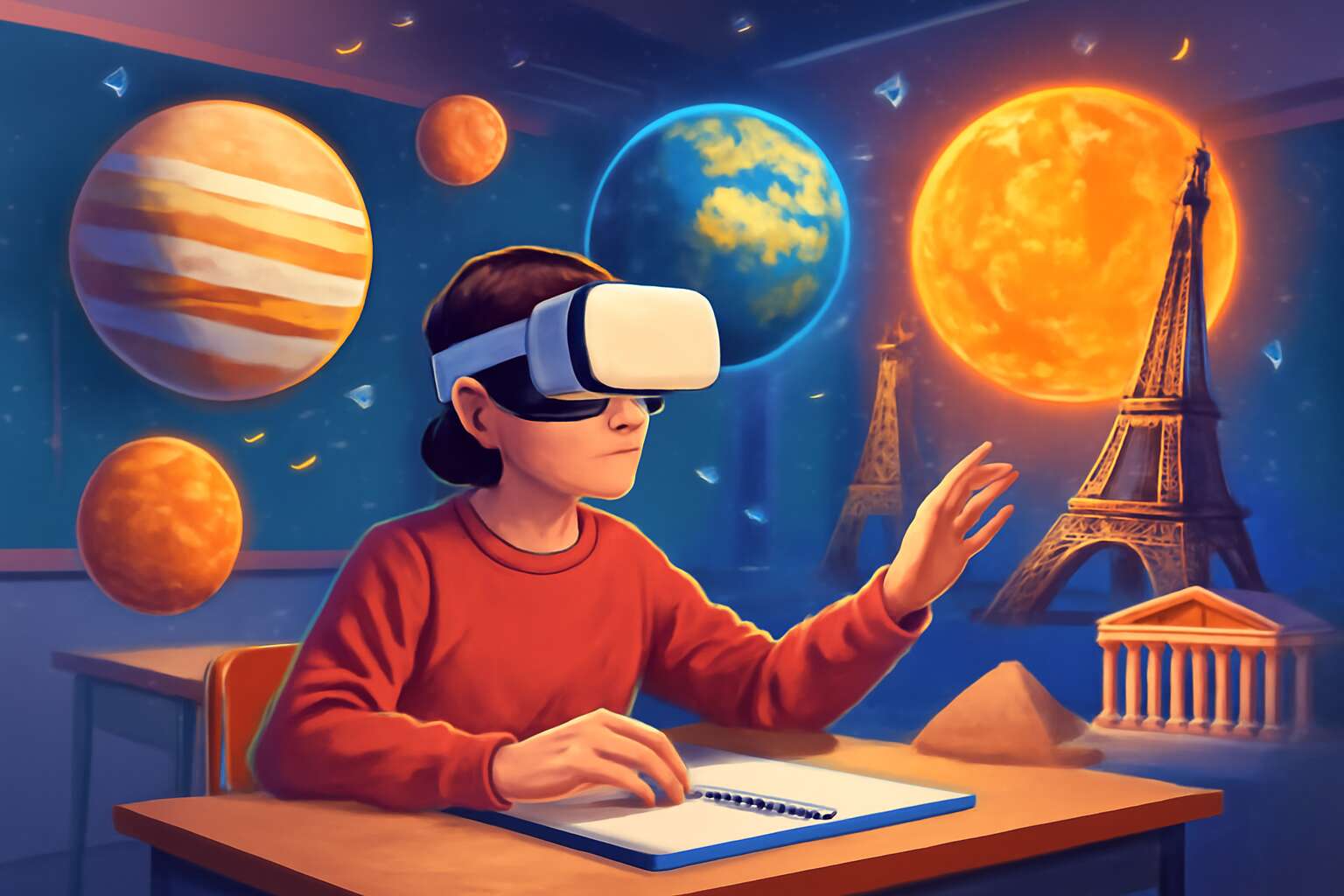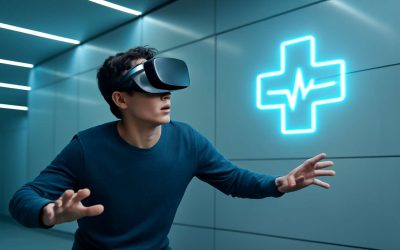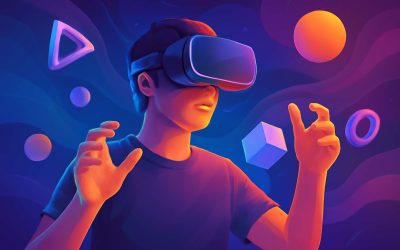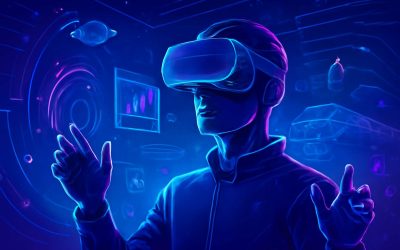Understanding Virtual Reality in Education
Defining Virtual Reality in an Educational Context
Imagine stepping beyond the confines of traditional classrooms, where learning becomes an immersive voyage into uncharted worlds. This is the essence of understanding virtual reality in education—a technological marvel that transforms passive absorption into active exploration. Virtual reality in education paints a new horizon, allowing students to traverse ancient civilizations, explore the depths of the oceans, or soar through the cosmos—all from the safety of their school desks.
At its core, virtual reality in education is a sophisticated simulation that immerses learners in a computer-generated environment, engaging their senses and igniting curiosity. It creates a bridge between the abstract and the tangible, making complex concepts tangible and memorable. For example, students can:
- Walk through historical landmarks as if they were there in person
- Examine intricate biological processes up close
- Practice real-world skills within a safe, controlled setting
In essence, virtual reality in education is not merely a technological trend but a profound tool that redefines the boundaries of learning, turning education into an adventure of discovery and wonder. It invites us to ask, “What if knowledge could be experienced rather than just learned?” and opens a portal to infinite possibilities.
Different Types of Virtual Reality Technologies Used in Education
Understanding virtual reality in education requires delving into the diverse array of technologies that make this immersive learning possible. Unlike traditional methods, virtual reality in education leverages cutting-edge tools to create an authentic sense of presence and engagement. Among these, the most prominent are head-mounted displays (HMDs), which transport students directly into virtual worlds, and CAVE systems (Cave Automatic Virtual Environment), which envelop them in a 3D space for collaborative learning experiences.
Additionally, augmented reality (AR) enhances the educational landscape by overlaying digital information onto the physical environment, offering a hybrid experience that bridges reality and virtuality seamlessly. These technologies serve different educational needs, from exploring ancient Egyptian ruins in history classes to practicing surgical procedures in medical training. As these tools become more accessible, understanding what is virtual reality in education is no longer just academic; it is a vital component of future-ready learning environments.
How Virtual Reality Differs From Other Digital Learning Tools
Virtual reality in education offers an enchanting portal into worlds once confined to the realm of imagination. Unlike traditional digital tools that simply deliver information, virtual reality transports students into immersive environments where learning becomes an active adventure. It’s a realm where the boundaries of time and space dissolve, allowing learners to walk through ancient civilizations or explore the depths of the ocean with startling realism.
What truly sets virtual reality apart is its ability to foster a sense of presence—a feeling that students are truly part of the experience. This sensory engagement enhances understanding and retention in ways that textbooks or videos often cannot match. For educators seeking to elevate their teaching methods, understanding what is virtual reality in education reveals a tool that transforms passive learning into a vivid, participatory journey.
In essence, virtual reality offers an unparalleled bridge between the tangible and the fantastical, enriching the educational landscape with depth and dimension. It’s no wonder that this technology is rapidly becoming an indispensable element of future-ready classrooms—where curiosity is sparked and knowledge takes flight!
The Benefits of Virtual Reality for Learning
Enhanced Engagement and Motivation
Imagine stepping into a world where learning becomes an immersive adventure—where textbooks fade into the background and students are transported to ancient civilizations, distant planets, or inside the human body. That’s the transformative power of virtual reality in education, turning passive learners into active explorers. A recent study revealed that students engaged with virtual reality are up to 75% more motivated to learn, because the experience taps into their natural curiosity and desire for discovery.
Enhanced engagement through virtual reality ignites a spark that traditional teaching methods often struggle to ignite. When students are fully immersed, they develop a deeper understanding of complex concepts and retain information longer. This heightened motivation fuels perseverance, especially in challenging subjects. The excitement of exploring new worlds or practicing skills in a safe, simulated environment makes learning not only effective but genuinely exhilarating. With what is virtual reality in education, the possibilities are virtually limitless—making every lesson an adventure you won’t forget.
Immersive Learning Experiences
Virtual reality in education unlocks a realm of immersive learning experiences that transcend the limitations of traditional classrooms. When students don VR headsets, they are transported into environments that foster curiosity and critical thinking, making abstract concepts tangible. This technology enables learners to engage with content on a sensory level, deepening understanding and retention far beyond passive reading or listening.
One of the most compelling aspects of virtual reality in education is its capacity to simulate complex scenarios safely. For instance, medical students can practice surgeries or explore anatomy in 3D without real-world risks. Similarly, history enthusiasts can walk through ancient cities or witness historical events unfold before their eyes. These experiences not only captivate but also cultivate skills like problem-solving and spatial awareness, which are vital in today’s interconnected world.
- Enhanced engagement through realistic simulations
- Personalized learning journeys tailored to individual needs
- Opportunities for experiential learning that build confidence and competence
In a rapidly evolving educational landscape, understanding what is virtual reality in education is crucial. It offers a transformative approach—one where learners become active participants in their own discovery, forging a deeper connection with knowledge that is both meaningful and memorable. The potential for virtual reality to redefine the boundaries of learning is nothing short of revolutionary, especially in diverse contexts like South Africa, where access to experiential opportunities can be limited.
Improved Retention and Comprehension
In the labyrinth of learning, retention is the key to unlocking lasting understanding. Virtual reality in education transforms this process by immersing students in experiences that anchor knowledge deep within the mind. When learners engage with vivid, sensory-rich environments, their brains form stronger neuroconnections, making abstract concepts tangible and memorable. This heightened engagement fosters an emotional connection to the material, which significantly improves retention and comprehension.
Research suggests that virtual reality can boost information retention rates by up to 75%, an astonishing figure that underscores its power. Unlike traditional methods, virtual reality creates a multisensory learning landscape—one where learners can manipulate, explore, and interact with content in real-time. This active participation elevates cognitive engagement, leading to a profound understanding that pure reading or listening often fails to achieve. In the context of South African classrooms, where diverse learners face varying challenges, understanding what is virtual reality in education becomes crucial, as it offers an inclusive pathway to meaningful learning experiences.
Accessibility and Inclusivity in Education
Virtual reality isn’t just a flashy gimmick; it’s a game-changer for educational accessibility and inclusivity. Imagine a classroom where every student, regardless of physical ability or geographic location, can step into the same immersive universe of learning. That’s the real power of virtual reality in education—breaking down barriers that once seemed insurmountable.
By offering tailored experiences, virtual reality provides an equitable platform for diverse learners. For students with disabilities, VR can simulate environments that cater to specific needs, creating a sense of participation that traditional methods often lack. It’s like giving every learner their own personalized gateway into knowledge, no matter their starting point.
- Accessible content that adapts to various learning styles
- Real-time interaction for students with mobility challenges
- Global classrooms, connecting learners across continents
Understanding what is virtual reality in education becomes crucial as this technology continues to revolutionize how we teach and learn. It transforms education into a truly inclusive experience, where everyone has the opportunity to explore, discover, and grow—no matter where they are or what challenges they face.
Applications of Virtual Reality in Education
Virtual Field Trips and Historical Reconstructions
Imagine stepping into a different time and place without leaving your classroom. Virtual reality in education unlocks this possibility, transforming traditional learning into a journey of discovery. One of the most captivating applications is virtual field trips, where students can explore the pyramids of Egypt, the Amazon rainforest, or historical landmarks—immersive experiences that ignite curiosity and enhance understanding.
Beyond simple exploration, virtual reality allows for intricate historical reconstructions. These reconstructions provide a window into the past, enabling learners to witness ancient civilizations or significant events firsthand. Such vivid recreations deepen engagement and foster a sense of connection that textbooks alone cannot achieve. As a result, students develop a more profound grasp of history, geography, and culture, making the question of what is virtual reality in education not just a theoretical inquiry but a practical tool for immersive learning.
Simulations for Science and Medical Training
In the realm of education, virtual reality has transcended mere novelty, becoming a pivotal instrument for immersive scientific and medical training. Its capacity to simulate complex procedures and hazardous scenarios offers students a safe yet profoundly realistic environment to hone their skills. For instance, aspiring surgeons can practice intricate operations within a virtual operating room, where every nuance of tissue and instrument interaction is meticulously recreated. This technology transforms abstract concepts into tangible experiences, fostering a deeper understanding of anatomy, physiology, and procedural protocols.
Moreover, virtual reality simulations serve as invaluable tools for emergency response training, allowing learners to navigate high-stakes situations with heightened confidence. An engaging aspect of these applications is the ability to tailor scenarios to specific learning needs, creating a personalized journey through complex concepts. This adaptability ensures that students are not merely passive recipients but active participants in their educational journey. When considering what is virtual reality in education, these simulations exemplify its transformative power—blurring the line between theory and practice in a way that is both compelling and profoundly effective.
Language Learning and Cultural Exchange
Virtual reality has revolutionized language learning and cultural exchange, offering immersive experiences that transcend geographical boundaries. In South Africa, where diverse languages and cultures intertwine, VR creates unique opportunities for students to engage with global traditions and dialects firsthand. Imagine walking through the bustling streets of Marrakech or practicing conversational isiZulu in a virtual marketplace—these experiences foster authentic language acquisition and cultural appreciation.
One of the most compelling applications of virtual reality in education is its ability to simulate real-world interactions, making language practice more engaging and effective. For instance, VR platforms can host virtual cultural festivals or language immersion programs, where learners actively participate rather than passively observe. Such immersive environments help deepen understanding and retention, making the question of what is virtual reality in education more relevant than ever.
Moreover, VR enables educators to tailor cultural scenarios to individual learning needs, ensuring personalized and impactful learning journeys. As a result, students develop not only linguistic skills but also intercultural competence—an essential attribute in today’s interconnected world. Whether through virtual language exchanges or historical reconstructions, virtual reality bridges gaps and fosters global connections, transforming traditional educational paradigms.
Vocational and Technical Training
In vocational and technical training, virtual reality opens a new realm of possibilities, transforming traditional learning into captivating, hands-on experiences. Imagine a budding electrician donning a VR headset to practice wiring a complex circuit without the risk of electrical shock or damage—this is the promise of virtual reality in education. It allows students to engage with real-world scenarios in a controlled, safe environment, fostering confidence and competence.
For trades such as plumbing, carpentry, or automotive repair, VR simulations provide practical exposure that was once limited by access to tools or workshop space. The technology can replicate intricate processes, guiding learners step-by-step through procedures, ensuring mastery before they work on actual equipment. This immersive approach accelerates skill acquisition, making learning both efficient and effective.
Some of the most impactful applications include:
- Simulation of machinery operation and maintenance
- Virtual workshops for hands-on skill development
- Scenario-based training for emergency response
By integrating virtual reality into vocational and technical education in South Africa, institutions can bridge gaps in resource availability and provide equitable training opportunities. The question of what is virtual reality in education becomes more tangible when you see how it empowers learners to develop critical skills in a safe, engaging environment—preparing them to meet real-world challenges head-on!
Challenges and Limitations of Virtual Reality in Education
Cost and Infrastructure Requirements
While virtual reality in education promises revolutionary shifts in how students learn, it is not without its hurdles. One of the most significant challenges lies in the cost and infrastructure requirements. Implementing virtual reality technology demands substantial financial investment, not only for the hardware such as headsets and sensors but also for ongoing maintenance and software updates. Many educational institutions, especially in South Africa, grapple with budget constraints that make such advanced technology seem out of reach.
Beyond the initial expense, there’s the need for a robust technological infrastructure—reliable high-speed internet, adequate power supply, and technical support staff. Without these essentials, integrating virtual reality in education risks becoming a superficial gimmick rather than a transformative tool. The disparity in access can deepen existing educational inequalities, leaving underfunded schools further behind. As we explore what is virtual reality in education, understanding these limitations is crucial to paving a sustainable path forward.
Technical Issues and User Experience
While virtual reality in education holds incredible promise, it is not without its hurdles—particularly when it comes to technical issues and user experience. One of the most persistent challenges is ensuring a seamless and immersive experience. Lag, glitches, or low-quality visuals can quickly shatter the sense of presence that makes virtual reality so captivating. When technology falters, students may become frustrated or distracted, undermining the very engagement that VR aims to foster.
Moreover, user discomfort such as motion sickness or eye strain can deter learners from fully embracing virtual reality experiences. This highlights the importance of optimized hardware and software that prioritizes comfort and accessibility. To navigate these obstacles, some institutions implement
- rigorous testing of devices
- training for educators
- user-friendly interfaces
ensuring that the technology enhances learning rather than complicates it. Understanding these technical limitations is essential when exploring what is virtual reality in education, as it shapes how this innovative tool can be effectively integrated to truly transform the classroom environment.”
Health and Safety Concerns
Despite its revolutionary potential, virtual reality in education is not without formidable challenges—particularly concerning health and safety. The immersive nature of VR can sometimes lead to motion sickness, eye strain, and disorientation, especially during prolonged use. These issues are not trivial; they threaten to diminish the learning experience and raise legitimate concerns about student well-being. As educators and technologists grapple with these limitations, it becomes clear that the safety and comfort of learners must remain at the forefront.
In regions like South Africa, where access to cutting-edge hardware may be uneven, these health concerns are compounded by infrastructural disparities. To address these risks, some institutions implement strict time limits and monitor student responses carefully. Additionally, specialized hardware designed to reduce discomfort—such as ergonomic headsets and adjustable visuals—are increasingly vital. Understanding these health and safety concerns is essential when considering what is virtual reality in education, as it influences how this powerful tool can be responsibly integrated into diverse learning environments.
Lack of Standardization and Content Quality
While the buzz around virtual reality in education continues to grow, it’s not all smooth sailing. One glaring obstacle is the lack of standardization and content quality—imagine trying to teach a complex science concept with a hodgepodge of poorly designed VR modules. This inconsistency can turn an immersive experience into a confusing jumble, leaving students more bewildered than enlightened. Without universally accepted standards, educators are left to sift through a swamp of varying quality, often ending up with more questions than answers about what is virtual reality in education.
Furthermore, content creation is a costly affair, and not every institution in South Africa can afford top-tier VR experiences. This creates a digital divide, where only privileged schools benefit from high-quality virtual learning environments. To make matters worse, many VR programs lack the depth and rigor needed for serious academic pursuits, reducing what could be a transformative tool into a glorified video game. The absence of standardized, high-quality content hampers the full potential of virtual reality in education, making it a promising yet imperfect solution for now.
Future Trends and Developments in Virtual Reality for Education
Integration with Artificial Intelligence and Machine Learning
As technology continues to evolve at a staggering pace, the future of virtual reality in education promises to be nothing short of transformative. Integration with artificial intelligence (AI) and machine learning is paving the way for personalized learning experiences that adapt to each student’s unique pace and style. Imagine virtual classrooms that respond dynamically, offering tailored feedback and immersive content that evolves based on real-time data. These advancements are set to revolutionize how learners engage with complex subjects, making education more interactive and impactful.
Looking ahead, several exciting developments are on the horizon:
- AI-powered virtual tutors that provide instant, personalized guidance tailored to individual learning needs.
- Adaptive virtual environments that modify scenarios dynamically, ensuring optimal challenge levels for every student.
- Enhanced data analytics to track progress with precision, fostering targeted interventions and support.
As we explore what is virtual reality in education, the seamless fusion with AI and machine learning will unlock unprecedented opportunities for immersive, inclusive, and highly effective learning environments across South Africa and beyond! This technological synergy is poised to redefine the boundaries of traditional education, making learning more engaging and accessible for all learners.
Advancements in Hardware and Affordability
The future of virtual reality in education is looking brighter than a Johannesburg sunrise, thanks to technological leaps in hardware and affordability. As VR hardware becomes more advanced, it’s also becoming less of a luxury and more of a necessity—think lightweight headsets and wireless options that won’t make educators feel like they’re strapping on alien tech every morning.
One of the most promising developments is the dramatic drop in costs, making virtual reality in education accessible to schools across South Africa. No longer confined to elite institutions, VR headsets are now within reach for many, opening doors to immersive learning experiences that were once the stuff of sci-fi.
- Enhanced hardware capabilities, including higher resolution displays and improved motion tracking.
- Cheaper production costs, leading to more affordable devices for educational institutions.
- Streamlined setup processes, reducing the technical barriers for schools.
This evolution not only broadens the reach of virtual reality but also enhances its role in creating engaging, interactive lessons that truly stick. As hardware continues to evolve and costs continue to fall, the question of what is virtual reality in education will soon be answered with a resounding “every classroom, everywhere!”—a revolution that’s well underway in South Africa and beyond.
Collaborative and Social VR Learning Environments
Future trends in virtual reality for education are poised to transform the classroom into a bustling hub of collaboration and social interaction. Imagine students across South Africa connecting in real-time within a shared virtual space, working together on projects that transcend geographical boundaries. This isn’t just about individual immersion; it’s about creating social VR learning environments that foster teamwork, peer-to-peer learning, and cultural exchange—all from the comfort of a classroom or even a home.
As virtual reality technology matures, we’re seeing a shift toward more collaborative platforms that enable teachers and students to interact seamlessly. Features like real-time voice chat, shared virtual whiteboards, and avatar customization will soon become the norm. These innovations make learning more engaging and dynamic, encouraging active participation rather than passive consumption.
- Enhanced social features that facilitate peer feedback and group problem-solving.
- Virtual breakout rooms mimicking real-world group work scenarios.
- Inclusive tools to support diverse learners and accommodate different learning styles.
With these developments, the question of what is virtual reality in education is rapidly dissolving. Instead, it’s evolving into a vibrant, interconnected ecosystem where learners not only absorb knowledge but also build relationships and develop skills needed for the digital age—an exciting horizon for South African schools and beyond!
Potential Impact on Traditional Education Models
The landscape of education is on the brink of a revolutionary transformation, driven by the rapid evolution of virtual reality technology. As educators and technologists explore the potential impact of virtual reality in education, it’s clear that traditional models are beginning to shift. Future developments point toward immersive environments that foster collaboration, cultural exchange, and experiential learning—far beyond the confines of textbooks and static classrooms.
One of the most exciting trends is the integration of social VR learning environments, which enable students to connect in real-time across distances. These platforms are not only making learning more engaging but also more inclusive. For instance, virtual breakout rooms and shared whiteboards mimic real-world group work, encouraging teamwork and peer-to-peer feedback. As these features become more sophisticated, the potential for a truly interconnected educational ecosystem grows stronger.
In the broader context, the question of what is virtual reality in education is evolving from a simple technological tool to a catalyst for pedagogical innovation. Schools could soon adopt virtual environments that replace traditional lectures with interactive simulations, making education more dynamic, accessible, and tailored to diverse learning styles. As these trends unfold, the traditional classroom may become a launching pad for limitless exploration and cultural exchange, transforming the very fabric of learning for generations to come.




0 Comments